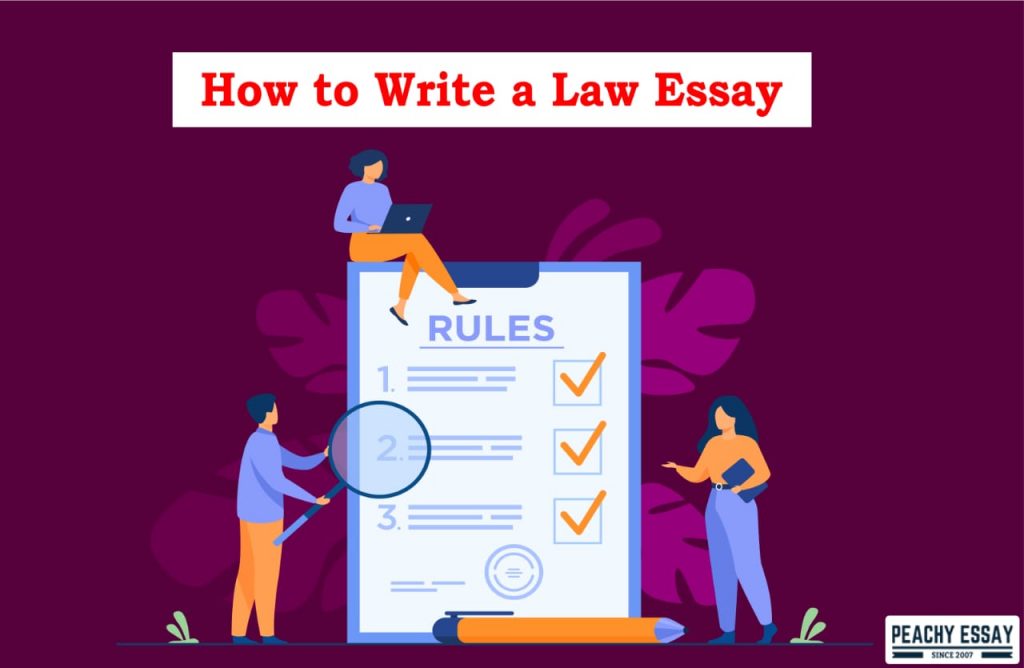Law is perhaps one of the most challenging disciplines in the scholarly world. Remaining and completing graduate school is an uphill task for many scholars. Law papers are one of the regular tasks given to test a law understudy’s skills and scientific abilities.
What is a Law Essay?
Law papers are scholarly assignments that investigate everything of the law. It might sound so basic; however, the difficulty here is that there is an expansive range of points that can be examined. With different expositions, the author needs to offer and give their input on the subject. The distinction in law articles is that the writer needs to uncover intricacies and loopholes clauses in the law and utilize those to fortify their contentions.
Types of Law Papers
Here are the sorts of law papers
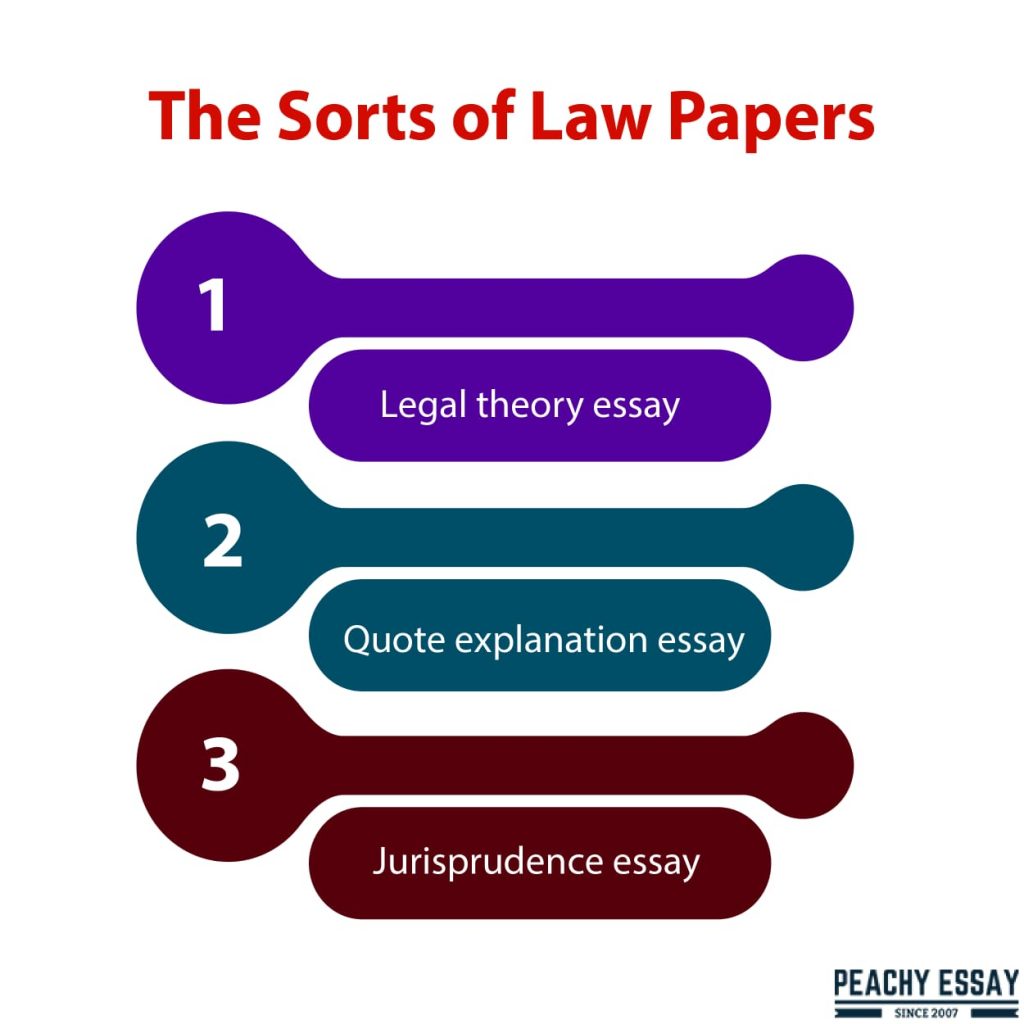
Legal theory essay
A lawful hypothesis paper basically plans to characterize and depict in detail a lawful hypothesis. Ideally, the foundation or history of the hypothesis is incorporated. The current importance of a hypothesis is regularly fused in the article.
Quote explanation essay
This law article’s substance is to uncover and decipher the statement’s significance from a lawful perspective. A few teachers even request that their understudies incorporate their info – if they concur or differ with the statement and give subtleties and contend regarding why.
Jurisprudence essay
Statute paper is viewed as the hardest among the three. An understudy should peruse, survey, and break down a particular case. Perception is of basic significance to this law exposition as the author needs to give an inside and out examination of the case.
How to Write a Law Essay
A great law understudy realizes how to contend in each medium. Regardless of whether it is through talking or composing, they should have the option to transfer their contentions in a coordinated and substantial way. It isn’t sufficient, subsequently, for law understudies to zero in on reinforcing their capacity to talk. The main prerequisite among law understudies realizes how to create great exposition papers.
The contrast between talking from writing regarding the contentions is that in the last-mentioned, the law understudy is given a lot of time to ponder on his and recognize which ones from his arms stockpile are frail merit sending in his paper. The basics of how to compose a law exposition are attached in realizing how to compose a paper. What is normal with law expositions is a very much developed argumentation emphatically grounded in the law’s actual intent.
Here are the means for composing a law article.
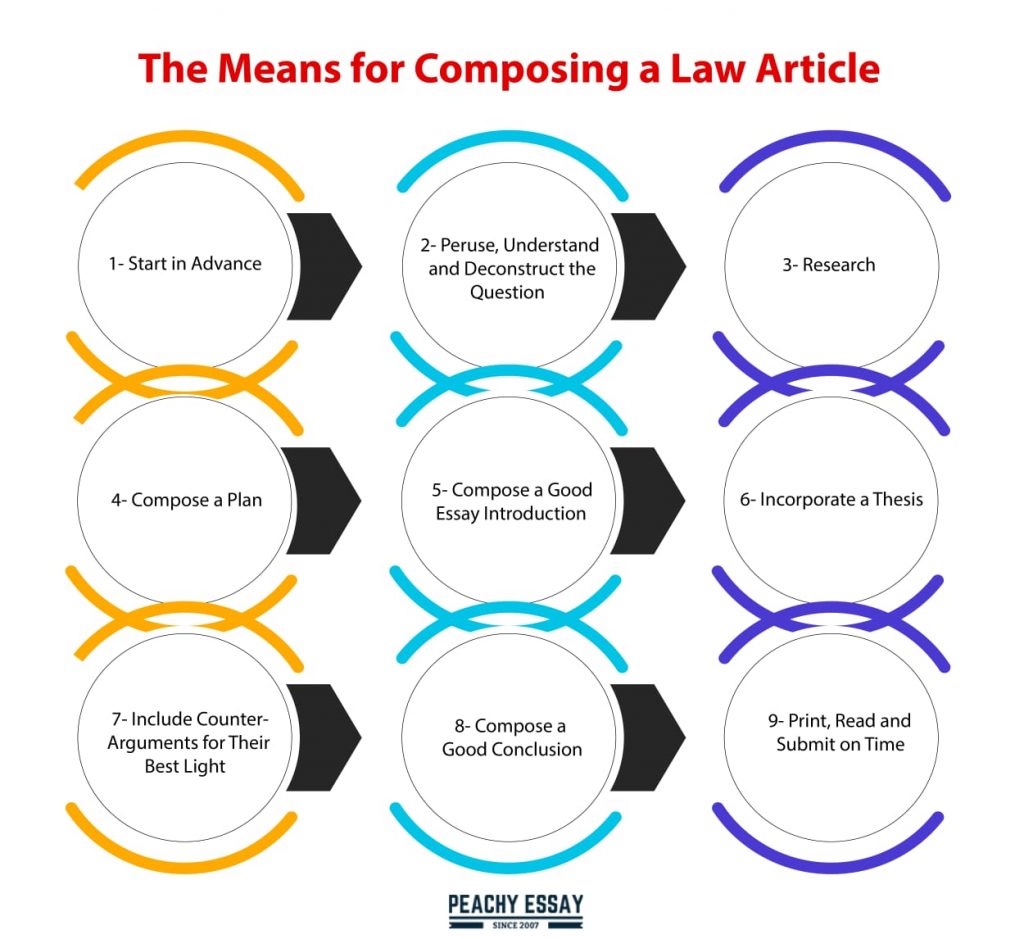
Start in Advance
You should begin your law paper when you have the inquiry. Leaving it until the last moment doesn’t just make superfluous pressure; however, it additionally leaves you an inadequate opportunity to compose, reference, and amazing your work.
Peruse, Understand and Deconstruct the Question
Try not to start until you completely grasp the inquiry. Enjoy time to reprieve the inquiry down into areas and visit your mentor for guidance. This will help hugely.
Research
This is seemingly the most significant piece of the law exposition composing measure. The data should be taken from significant, dependable, and exceptional sources. If not, this will debilitate your odds of creating a top-of-the-line law paper. The more authoritative a source, the more checks you will acquire. Utilize essential material over auxiliary where conceivable.
Compose a Plan
After researching, you will have a thought of what sort of ideas you need to place into your content. Take a piece of paper and compose what you wish to accomplish in each passage. This makes it simpler regarding composing the paper as a beginning without an arrangement that can get muddled. The paper should address the inquiry, and only the question, so ensure the entirety of your points identify with it.
Compose a Good Essay Introduction
An amazing presentation ought to, right off the bat, lay out the exploration point. Do this without essentially rehashing the given inquiry. Besides, make a guide for the reader, telling them how the exposition will move toward the inquiry. Thirdly, incorporate a thesis statement. Your presentation should be brief. The fundamental body of the exposition is the place where you will really expound.
Incorporate a Thesis
This is your assessment on the current matter and will normally go into your introduction. Take a reasonable position, don’t be hesitant. Abstain from taking a conspicuous view; being diverse is acceptable. Before composing, inquire as to whether you can demonstrate your contention with the given word tally or if you need to embrace a more unassuming situation for the paper.
Include Counter-Arguments for Their Best Light
This will demonstrate your expansive comprehension of the point. Disprove these contentions and clarify why your contention is better. If you don’t perceive why your view is more grounded, you are eventually portraying two perspectives and afterwards arbitrarily picking one over the other. Keep in mind; your point is to convince the reader to embrace your position. The reader won’t be persuaded if you can’t show that your contention withstands opposing arguments.
Compose a Good Conclusion
Highlight all the central matters that you have made all through. Reaffirm your response to the law article question in your decision to ensure this is done plainly.
Print, Read and Submit on Time
Request that somebody read your paper and give you basic input. This is helpful as you might not have seen linguistic blunders. The individual in question need not be a legal counsellor as an elegantly composed paper should bode well to anybody.
Common Mistakes in Writing Law Essays
Not responding to the question
Before beginning with the examination and creative cycle, one should ensure that the question is seen impeccably. The understudy should ensure that they have not misread or misjudged the inquiry. Keep in mind; a law paper should address the inquiry and only the inquiry.
The contention is unclear
Possibly the understudy comprehended the inquiry, yet the issue is the introduction of the contention. Try to make the position clear at the earliest reference point and not simply present the contention close to the exposition’s end. That is tedious and brings down the coherence of the paper.
The argument lacks authority
A law understudy will, in general, utilize legitimate language and refined words to sound shrewd. Remember that law papers ought to sound shrewd and well-informed as well as should be supported by law. A case, rule, or lawful scholarly should be introduced as proof to support the contention.
Introducing pointless cases
Some law understudies are eager to flaunt the degree of their insight and tragically consolidate each case that they believe is associated with the current subject. Rather than improving the understudy’s evaluation, these demonstrations negatively affect the student since examining and assessing which cases to introduce are critical.
Improper paper formatting
Likewise, with all articles, the proper paper design is vital. Following the college prerequisites or the educator’s particular directions is indispensable. Never utilize hard-to-understand text styles and little text dimensions. Times New Roman with the text dimension 12 is the favored one to utilize. Capitalization, spelling, and references ought to be checked twofold.
Law Essay Outline
A law paper has an introduction, body, and conclusion. Note that a law article is likewise a pugnacious exposition. As a law article, it includes a particular arrangement of standards for its parts and its proof.
Here are the areas of a law article’s outline.
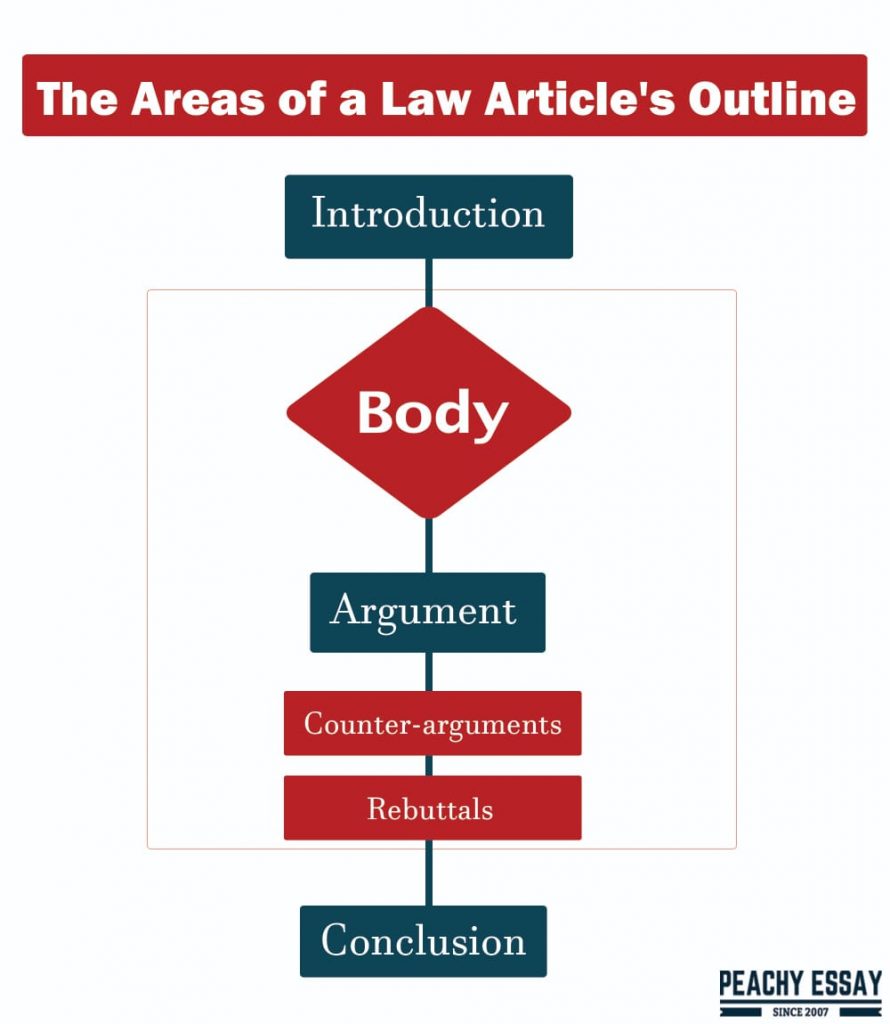
Introduction
Ensure that the prologue to law paper follows the typical recipe of a proper exposition. Fixing the tone and going directly to the point has a significant effect. Giving a concise foundation on the point and question is ideal. From that point forward, the contention is promptly introduced. Ordinarily, the thesis statement or contention is just a sentence long; however, it tends to be extended to two sentences if necessary.
The thesis statement is the principal guarantee that the law understudies advances, which endeavors to address the current inquiry. This is a fragile piece of the article composing measure. The law understudy should ensure that his thesis statement straightforwardly addresses the inquiry. It should be clear to reduce the opportunity for the law understudy’s words to be wound in a counter-contention.
Following that is a concise conversation of what is to be examined. A guide to managing the reader through the whole paper is frequently incorporated to realize what’s in store and not get lost, particularly if it is a complex law exposition. The conversation should contain what the issue is here, why it is an issue in any case, and why it should be settled appropriately.
Body
The body contains the majority of the law understudy’s argumentation. It endeavors to expand upon the primary case set forward by the law understudy in his thesis statement. Here, the contention is given in much detail. As referenced before, law papers are basically factious expositions. All things considered, law understudies should examine their own argumentation and conceivable counter-contentions to their cases and their rejoinders to those counter-contentions.
Arguments
The contentions of the law understudy endeavor to offer help to the primary case in the proposed explanation. Every contention set forward should be particular from each other and can likewise exist together to support the fundamental cause. A contention ought to consistently address the inquiry and not meander a long way from the thesis statement. In law expositions, contentions ought to consistently be upheld by proof. This regularly comes as references to existing laws and guidelines. Another sort of proof is through past cases that elaborate deciphering the referred to laws. These are classified as “precedents,” and if they made a gigantic blemish on enactment, these are “landmark cases.” These can be important to the law understudy’s argumentation.
Counter-arguments
Counter-contentions endeavor to oppose the law understudy’s principle case and supporting contentions. Regularly, these are dictated by the law understudy, as they are prepared to expect such rejoinders during homeroom recitation. All things considered, it is hard for a law understudy to counter their own argumentation since they will, in general, be one-sided towards their cases. With enough exertion, it is conceivable.
For best outcomes, notwithstanding, the law understudy may frame or join an investigation group to get more contribution on the best way to best safeguard his contention. The understudy should show them his argumentation and request the individuals from the investigation bunch to contend against it. Cooperation is fundamental in considering law.
Similarly, as with the contentions, the general guideline is that the law understudy advances around three counter-contentions to take into account adequate clarification while as yet remaining inside the word tally.
Rebuttals
The law understudy can’t just express the counter-contentions without addressing to them. A law understudy’s counters further exhibit his basic reasoning and capacity to contend. Once more, an investigation group is useful in this assignment since they can call attention to loopholes that the author has disregarded.
A law understudy’s rebuttals should show either the shortcoming or paradox behind the counter-contentions. The objective is to nullify the counter-contentions and, in this way, fortify the primary case. Likewise, with the law understudy’s contentions, these should be grounded in proof, either by referring to explicit laws or referring to points of reference.
There are, however, many replies as there are counter-contentions. In any case, the law understudy should notice succinctness in showing the rebuttals.
Conclusion
Like how it is done in a conventional article, the law paper’s determination endeavors to sum up every one of the points that the law understudy sent. The contentions here are combined as the law understudy gives a last, complete comment on how they fortify his primary case. The law understudy likewise clarifies how his general argumentation is adequate to address the fundamental inquiry. Note that no new contentions, thoughts, or ideas should be introduced in a law paper’s decision.
Tips for Writing Law Essay
Here are the tips for composing a decent law paper
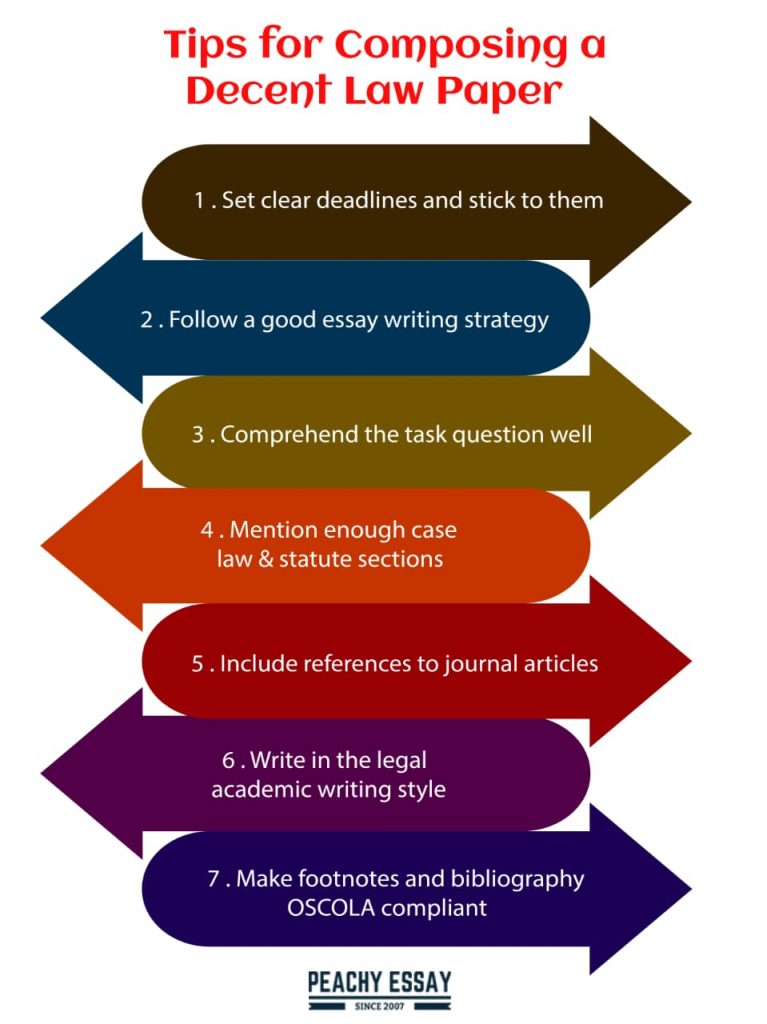
Set clear deadlines and stick to them
The initial step toward composing a decent law exposition is to make a framework of time you will need to compose your article and adhere to your arrangement. One of the serious mix-ups made by understudies when dealing with their articles is that they leave everything to the last second and afterwards attempts to handle the entirety of the expositions they need to submit simultaneously. Doing that will add to your feelings of anxiety, so attempt to keep away from it.
Follow a good essay writing strategy
Utilizing a demonstrated exposition composing system can truly assist you with creating great quality law papers. Instead of working in a disorganized manner, you ought to have an apparent arrangement of how you will move toward composing your article from the start as far as possible. Normally, it would help if you began by perusing your lecture materials, follow up by perusing the significant course reading sections, and afterwards, a couple of chosen diary articles on the subject.
Before you begin dealing with your paper, you ought to make an article outline that will incorporate your exposition’s headings, the focal contention (for example, the topic of your article), and a list item rundown of what you will include for each passage of your paper.
Comprehend the task question well
Before you begin dealing with your exposition, you should ensure that you can truly comprehend the task question. This implies that you need to determine whether the inquiry you are dealing with is a paper question or a problem question.
Problem questions are ordinary situations portraying a few occasions experienced by at least one individual, in which you are approached to prompt them on their lawful position. Paper questions, then again, are generally made out of a couple of sentences that request you to give your assessment on a specific region from the law. This differentiation is something that most understudies effectively master in their first year at graduate school.
Mention enough case law & statute sections
Since you are composing law expositions, you need to ensure that you talk about the real law in your paper, rather than what you might suspect the law is. This means you need to ensure that your article incorporates sufficient resolution areas and cases. A decent general guideline is that if you are composing a law paper of 2,500 words, you should refer to at any rate 10-15 cases.
The quantity of resolution segments relies upon the law’s space and the subject you are expounding on. You may run over task subjects in which your solitary assignment will be to examine one specific part of a particular rule, in which case you will zero in on that segment just all through your article, alluding to at least 10-15 cases which decipher it.
But it should be that your subject will expect you to investigate a few diverse resolution segments. Likewise, you will go over specific law spaces, like the EU law, where there are normally fewer cases to talk about. However, you need to examine those couple of cases in considerably more detail. Nonetheless, in by far most law expositions, the standard of 10-15 cases for every 2,500 words will turn out great.
Include references to journal articles
It may be enticing to skip perusing journal articles on the subject of your exposition. Yet, all great law papers incorporate probably a few references to journal articles. All in all, every article ought to incorporate a few conversations of scholastic assessment (for example, references to the sentiments introduced in law journals) alongside counter-contentions made by the author.
Ordinarily, a law exposition should contain references somewhere in the range of 5 and 10 journal articles, contingent upon its word count. However, if you are managing a complicated exposition subject and are attempting to comprehend the journal articles examining it, center on perusing 2 to 3 articles and understanding them alright to have the option to specify them in your paper.
Write in the legal academic writing style
The legitimate scholarly composing style is the authority style utilized by scholastics in journal articles. It is also the style that law understudies ought to seek to use in great law papers. It is a method of expounding on cases, resolutions, and journal articles that is unmistakable to the lawful calling in the UK. It includes utilizing various sentence designs to support your contentions frequently utilized by law scholastic as well as highlighting the relevant keywords.
Make footnotes and bibliography OSCOLA compliant
The OSCOLA referencing style is the key style utilized by UK graduate schools when making footnotes and bibliographies. It is utilized in all UK-published legal journal articles, which you will run over, and it is likewise a fundamental segment of all great law expositions.
If you need to create a top-notch law assignment, you should focus on the little subtleties included in the OSCOLA guide. This incorporates where to place the commas and the full stops in your references and whether the title of a journal article should be put in italics or quotes.

